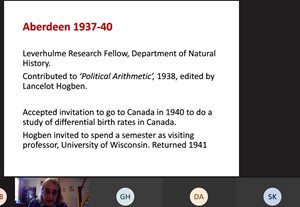The RSS Highlands local group and the History of Statistics Section celebrated 2021 International Women’s Day on 8 March 2021 with a webinar highlighting the statistical contributions of Enid Charles and Hilda Mary Woods, two pioneers in demography and health statistics respectively, who were elected fellows of the Royal Statistical Society (in 1947 and 1926 respectively).
Enid Charles (1894–1972) studied statistics and economics at Cambridge and social science at Liverpool. Her early career started late after having four children with her husband, Lancelot Hogben and she completed a PhD in physiology at the University of Cape Town. They returned to the United Kingdom where her husband held Chairs in Social Biology at the London School of Economics (1930-1937) and Natural History at the University of Aberdeen (1937-1940), while Enid Charles developed prominent population based research of her own in demography.

Professor Macfarlane describes Enid Charles’ beginnings studying birth rates
Alison Macfarlane (City, University of London) highlighted these landmark achievements in her talk 'Enid Charles, socialist feminist demographer and her analysis of the timing of birth'. Her presentation guided the audience through a journey from Charles’ statistics of birth-time to population predictions. Importantly, this trailblazer was among the first demographers to challenge eugenics. After working in Canada from 1940-46 for the Dominion Bureau of Statistics, now Statistics Canada, she returned to join her husband in Birmingham where she worked for the City Council, establishing a database of maternity and child welfare records and using them to investigate the timing of birth. Professor Macfarlane concluded her talk by highlighting how Charles’ most impactful work was that as a demographer for the World Health up until 1962.
See Professor Macfarlane's slides (PDF)
Hilda Mary Woods (1892–1971) initially studied the piano before developing an interest in statistics; a discipline in which she was trained by Major Greenwood. In her own words, 'I was shown some of the preliminary equipment of a statistician—Barlow's Tables, a large brown book of logarithms, a mysterious looking object called a calculating machine, and Yule's Elements of Statistics. My heart sank.'
As Mario Cortina Borja (University College London, pictured top) highlighted in his talk, 'Hilda Mary Woods and the negative binomial distribution', she would grow to love them. Together with Greenwood, she wrote multiple reports and a paper, and secured work at both the Lister Institute and the Ministry of Health. In 1928, Woods became the first female lecturer at the London School of Hygiene & Tropical Medicine and in 1931 she co-authored with William Russell 'An Introduction to Medical Statistics', one of the first textbooks in the field. After further epidemiological work for the Ceylon Government (1934-1938), she expanded her expertise to the area of nutrition, both at the Ministry of Food and as a member of the Nutrition Society (1945).
Professor Cortina Borja also covered an overview of the history of statistics and women graduates in mathematics during the 1910-1920. A discussion followed with the audience on the personal difficulties and hurdles that these and other trailblazing women had to overcome, including following their husbands from job to job, being forced to stop work because of the marriage bar, and even publishing their work under their partners’ names.
See Professor Cortina Borja's slides (PDF)
The legacy of Charles and Woods lives-on in the many women statistician succeeding today in an area of statistics where gender equality has greatly improved.
Authors
Altea Lorenzo-Arribas, Lorna Aucott, David Maclernon, Alison Macfarlane, Mario Cortina-Borja and John Aldrich.
References
Aldrich J (2013). Karl Pearson‘s Biometrika, 1901–1936. Biometrika, 100: 3–15. https://academic.oup.com/biomet/article/100/1/3/194154
Charles, E. (1951). Statistical utilization of maternity and child welfare records. British Journal of Social Medicine, 5: 41-61. https://www.ncbi.nlm.nih.gov/pmc/articles/PMC1012565/
Charles E. (1953). The Hour of Birth. Journal of Epidemiology & Community Health, 7: 43-59. https://jech.bmj.com/content/7/2/43.info
Cole TJ (2017) The remarkable life of Frances Wood. Significance. https://www.significancemagazine.com/science/563-the-remarkable-life-of-frances-wood
Farewell, V., Johnson, T., and Gear, R. (2012). Hilda Mary Woods MBE, DSc, LRAM, FSS (1892–1971): reflections on a Fellow of the Royal Statistical Society. Journal of the Royal Statistical Society, 175 (3): 799-811. https://rss.onlinelibrary.wiley.com/doi/full/10.1111/j.1467-985X.2011.01018.x
Farewell, V. and Johnson, A. (2012). The first British textbook of medical statistics. Journal of the Royal Society of Medicine, 105 (10): 446-448. https://www.ncbi.nlm.nih.gov/pmc/articles/PMC3480860/
Wargon, S.T. (2005). Legacy of Enid Charles, 1894-1972. Canadian Studies in Population, 32 (2): 137-153. https://journals.library.ualberta.ca/csp/index.php/csp/article/view/15945